Jhofland has designed a very slick solid state relay (SSR) headphone DC protection module that has no mechanical relay to wear out and uses ultra low Rdson MOSFETs that do not alter the signal in any way (as previously shown via measurements on the RTR SSR DC protection board for speakers). This unit however uses comparators to check for the DC offset, which is set at +/-500mV. A CRC filter is used prevent audio transients from inadvertantly triggering the relay. The comparators then trigger an optoisolator which then activates the gates of a pair of back-to-back MOSFETs as the SSR. The module is also stereo, so only a single board is needed for a headphone amplifier. It needs a +/- voltage power supply from the amp's rails with at least +/-8vdc and less than +/-30vdc. This is regulated down to +/-5vdc for the comparators to function. The MOSFETs are rated to 30v presently and are 10mOhm RDson units SQ4282EY)
Unit is very compact: 45mm x 37.5mm and uses 8-pin Molex KK connector for all connections.
Works great for DC coupled preamps as well to avoid turn on / turn-off thump. Delay for turn on is 2.5 seconds, turn off depends on how quickly PSU caps bleed off upon power off. But generally turn off thump is not as bad as turn on thump.
Schematic:
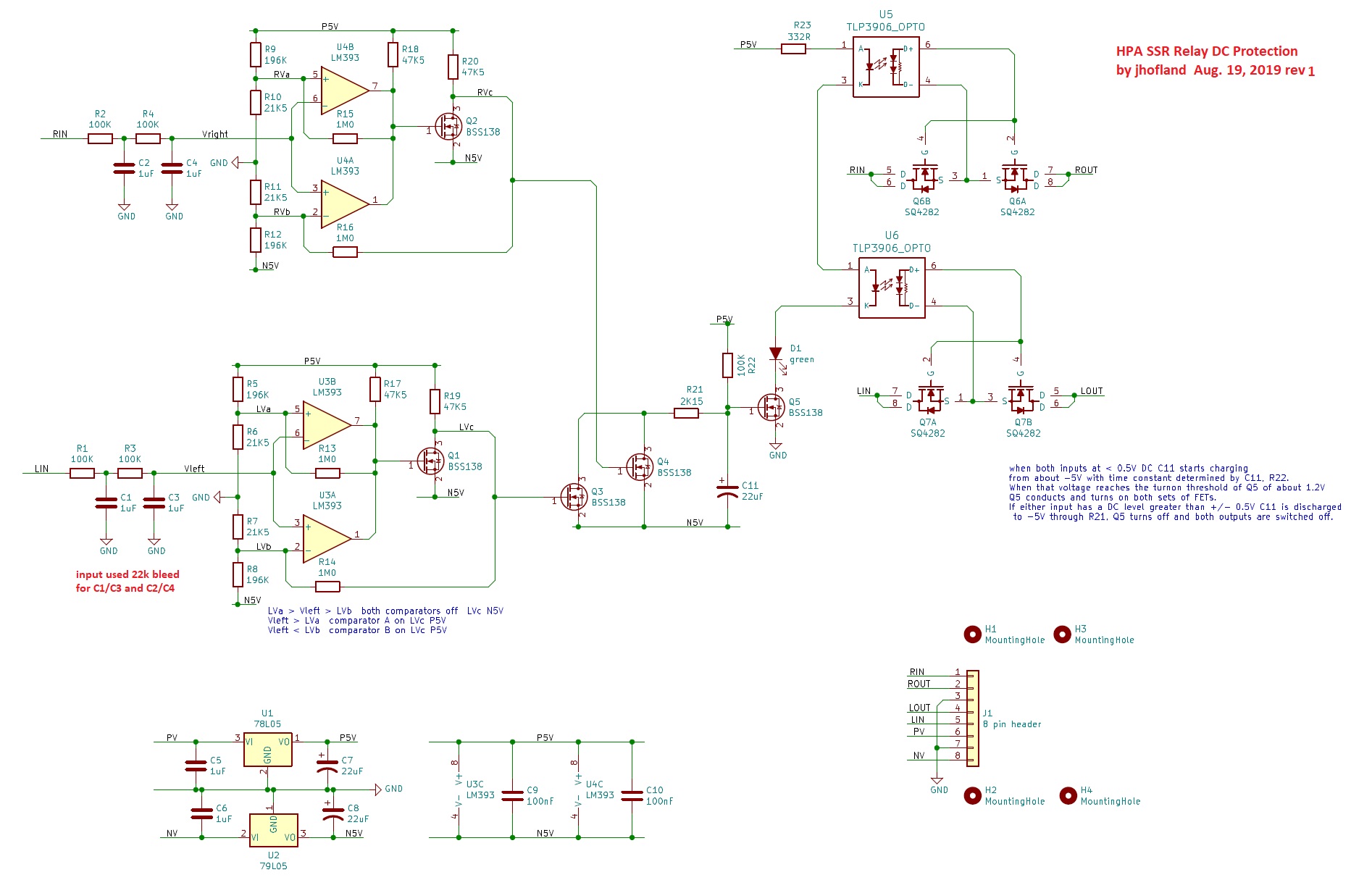
Build topside:
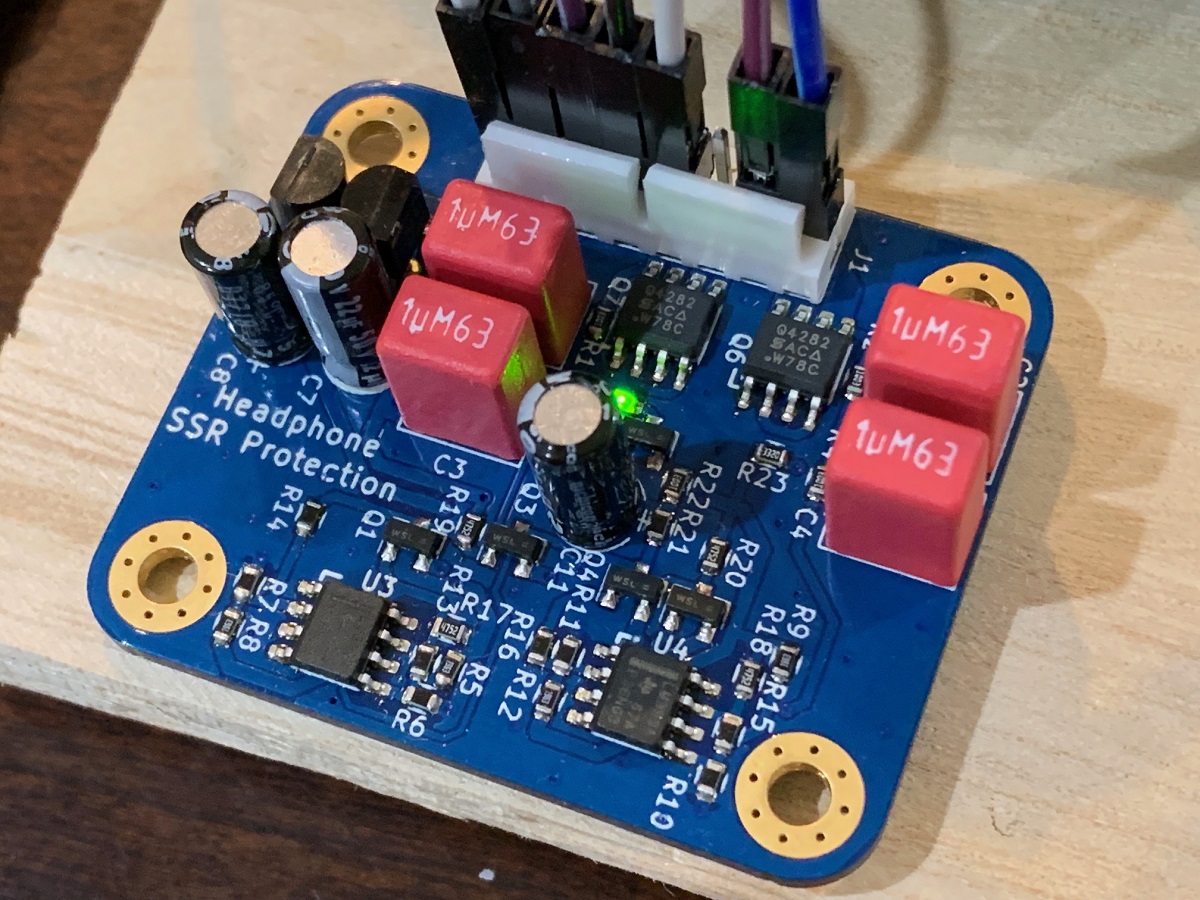
Build bottom side:
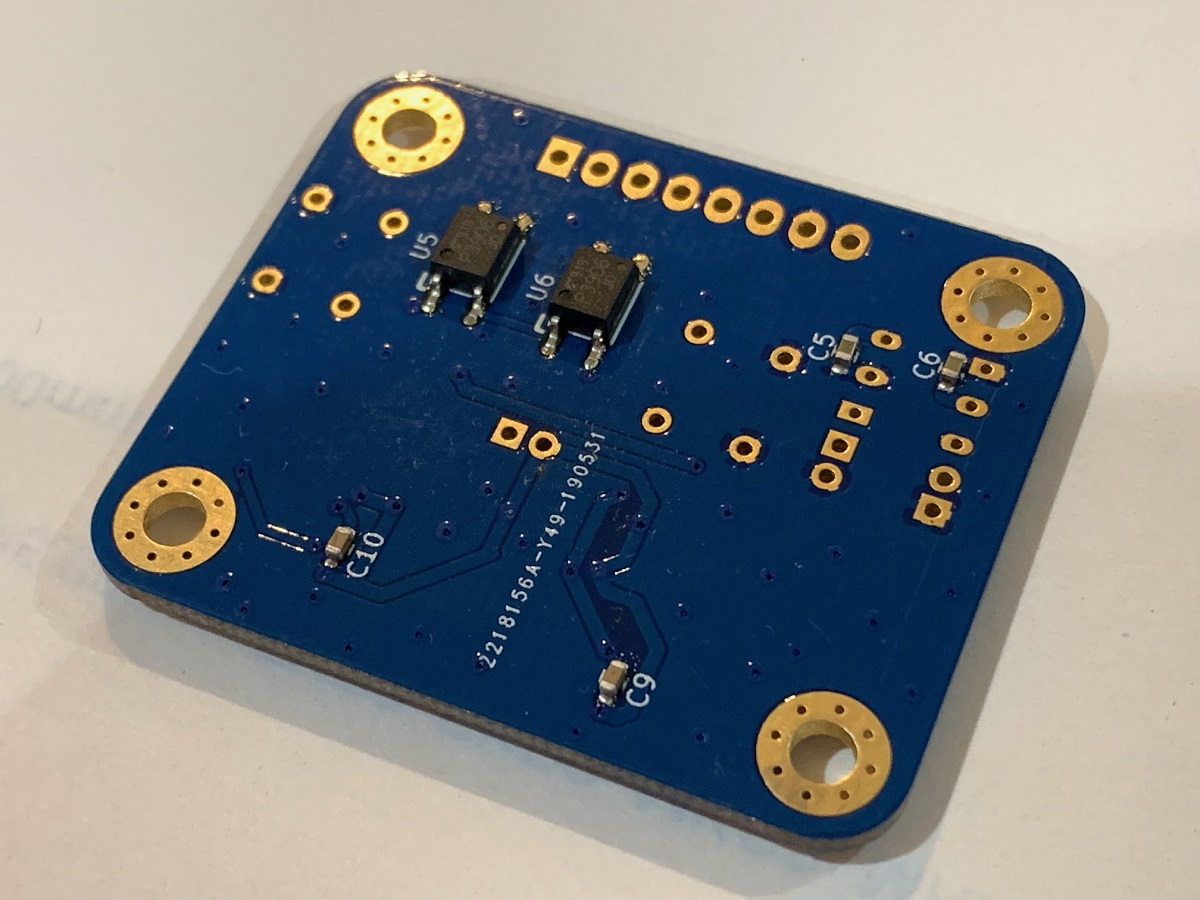
Test with parallel 8x OPA1622 headphone amplifer:
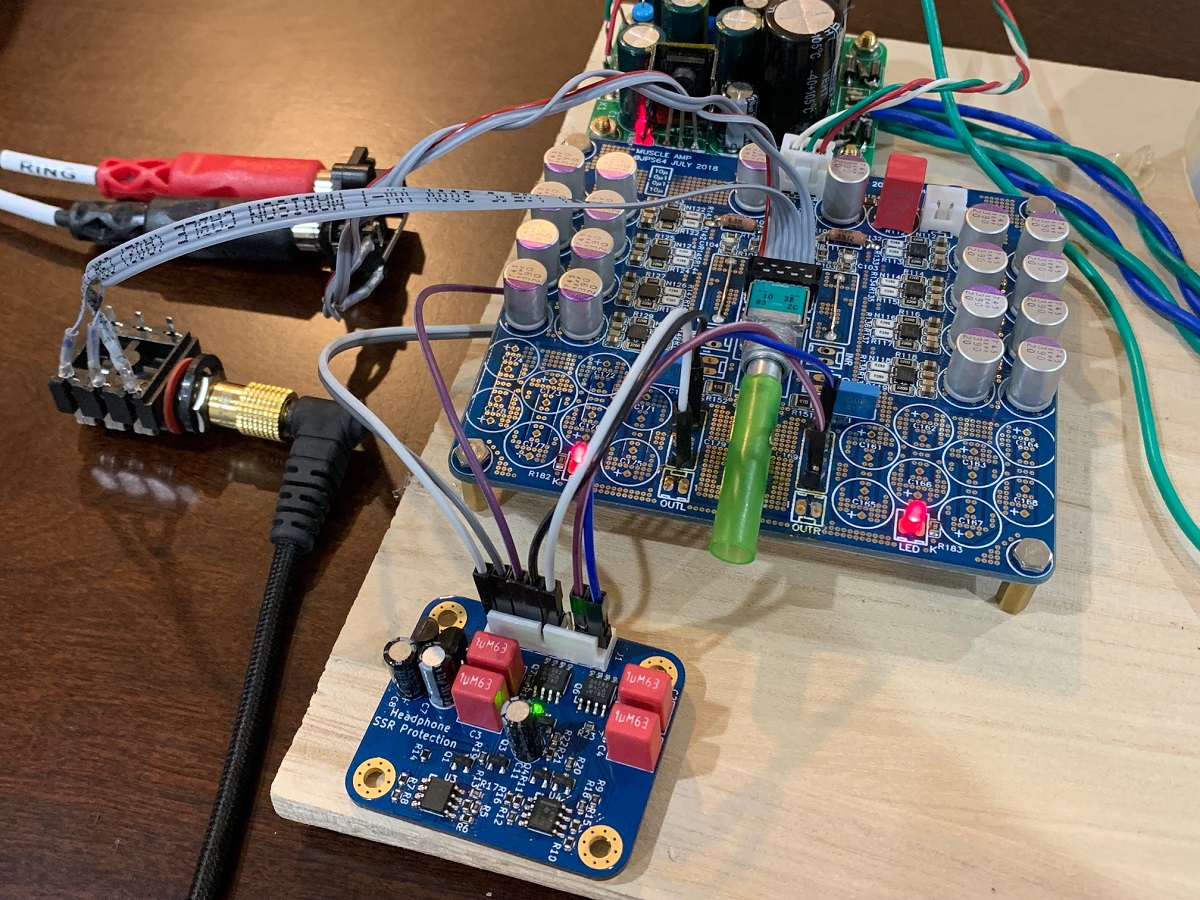
FFT showing harmionic distortion spectrum and THD without the SSR DC protection in place for 2Vpp into 51ohm load (9.2ppm THD):
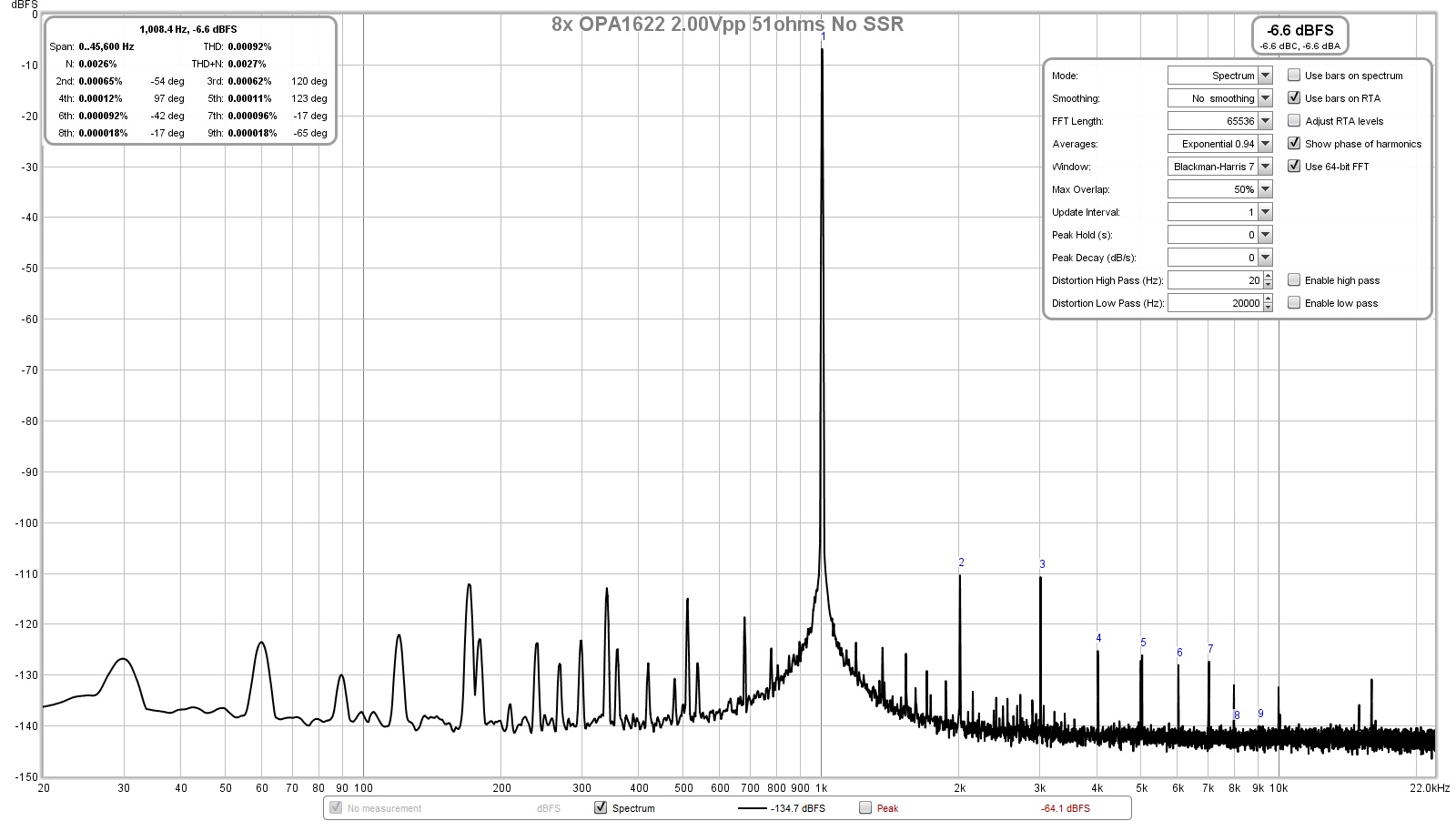
FFT showing same with the SSR DC protection module in place (still 9.2ppm THD):
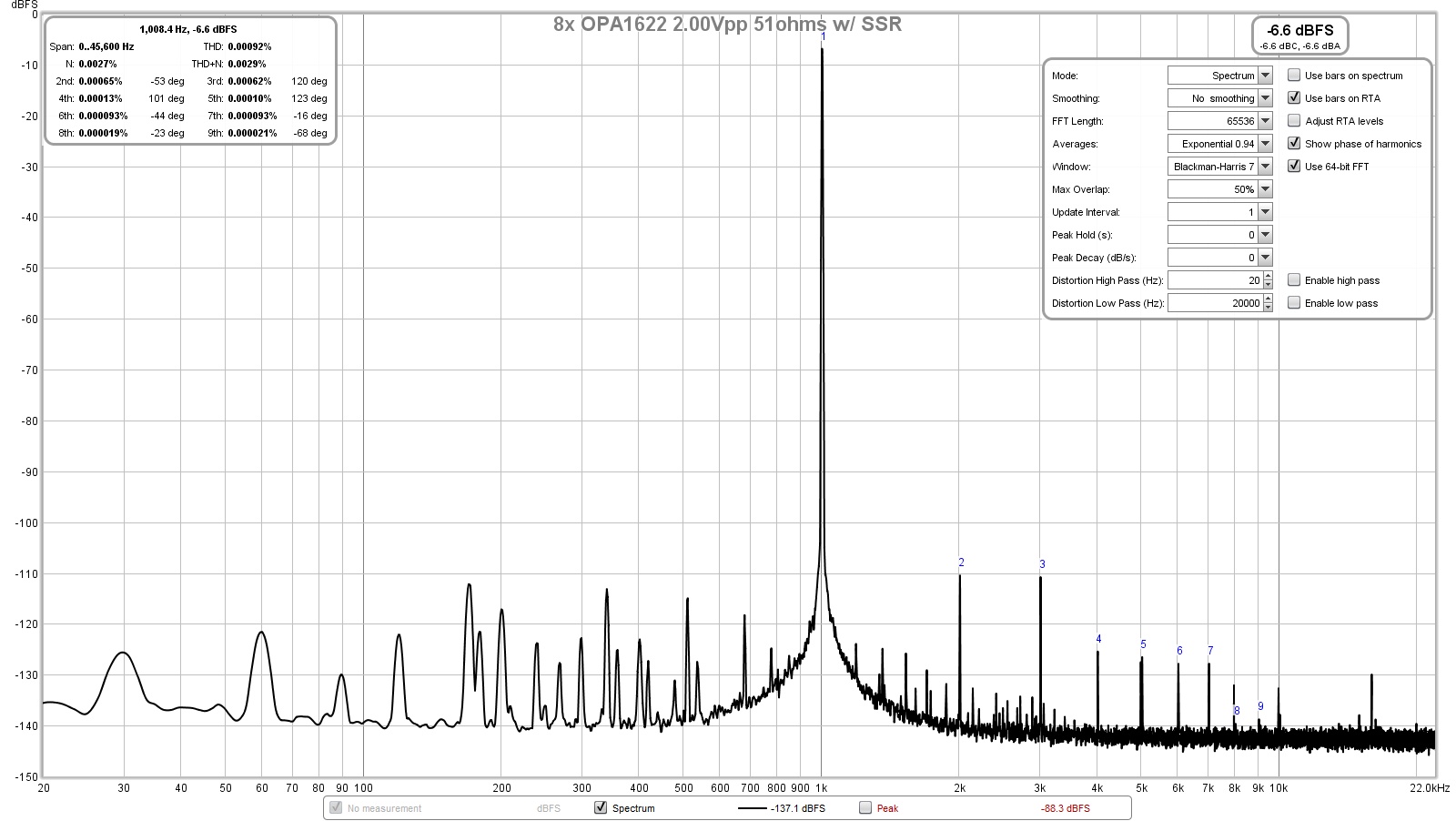
The unit works reliably and quickly and will protect your headphones from a DC offset error that could blow them up.
These are available as bare PCBs in my shop:
SSR Headphone Protection PCBs | Etsy
Unit is very compact: 45mm x 37.5mm and uses 8-pin Molex KK connector for all connections.
Works great for DC coupled preamps as well to avoid turn on / turn-off thump. Delay for turn on is 2.5 seconds, turn off depends on how quickly PSU caps bleed off upon power off. But generally turn off thump is not as bad as turn on thump.
Schematic:
Build topside:
Build bottom side:
Test with parallel 8x OPA1622 headphone amplifer:
FFT showing harmionic distortion spectrum and THD without the SSR DC protection in place for 2Vpp into 51ohm load (9.2ppm THD):
FFT showing same with the SSR DC protection module in place (still 9.2ppm THD):
The unit works reliably and quickly and will protect your headphones from a DC offset error that could blow them up.
These are available as bare PCBs in my shop:
SSR Headphone Protection PCBs | Etsy
Last edited:
Yes, as long as your preamp power supply rails don't exceed +/-30v. The current MOSFETs are only rated to 30v. Most line preamps are no higher than +/-18v so you should be fine.
Last edited:
Hi X,
Hmm....I didn't think to use this SSR HPA DC Protection board in a linestage preamp? But, I have notice some preamps have large DC offset when first powered up and shut down. Does this board have a few second delay before signal passes through and instant disconnect when powered off?
Hmm....I didn't think to use this SSR HPA DC Protection board in a linestage preamp? But, I have notice some preamps have large DC offset when first powered up and shut down. Does this board have a few second delay before signal passes through and instant disconnect when powered off?
Yes, it also has a startup delay of a few seconds. It’s adjustable with a resistor or capacitor value change on R22 and C11. Nominally 100k and 22uF so easier to change 100k resistor. The cap has to charge up in order to activate the gate to the MOSFET. I think the default delay is about 2.5 seconds. Since the RC delay circuit is tied across the positive and negative power rails, as soon the rails collapse, the gate to the MOSFET is turned off, shutting down the SSR instantly.
Last edited:
Yes, exactly what prompted my question. I've got a couple of preamps that push out DC on power up/down, but not during operation.
But, I have notice some preamps have large DC offset when first powered up and shut down.
I forgot to mention that the production version of this will probably use all surface mount parts. I have come to realize that nothing is gained by using big 1uF film caps on the input low pass filter. The series resistor is 100k so essentially no appreciable audio signal goes this way and a 1uF X7R ceramic will do just as well and be a lot more compact. The neat thing about this module is that it is very compact (45mm x 37.5mm) - so you could stick it as an afterthought into almost any headphone amp or preamp case you have. It will use a single 8-pin Molex KK connector and it's done. You could just double sticky tape it to the chassis somewhere and not deal with drilling holes for installation (if you are lazy about stuff like that, like me). Installation will be a snap once you take your output wires and splice them into the KK connector, add 3 more wires for the +/- voltage and GND, and done.
Last edited:
That's encouraging. Would it be reasonable to mount this in its own case with a separate power supply, and insert between the preamp outputs and the amp?
X,
Will the surface mount components be sized so we don’t need an electron microscope to see them if we wanted to diy the board? 😀
Will the surface mount components be sized so we don’t need an electron microscope to see them if we wanted to diy the board? 😀
RTR SSR HPA Protect GB Interest List update:
ok, let's see how many more people are interested in this, as I said before, we need 50 units to make this a RTR possibility, otherwise, it will be strictly a DIY PCB self-assembled SMT kind of thing.
Name / Qnty / Country
mbrennwa / 2 x RTR / Switzerland
Gtkaudio ?
Vunce ?
Pinocchio ?
ok, let's see how many more people are interested in this, as I said before, we need 50 units to make this a RTR possibility, otherwise, it will be strictly a DIY PCB self-assembled SMT kind of thing.
Name / Qnty / Country
mbrennwa / 2 x RTR / Switzerland
Gtkaudio ?
Vunce ?
Pinocchio ?
X,
Will the surface mount components be sized so we don’t need an electron microscope to see them if we wanted to diy the board? 😀
If we scrub the RTR option and go DIY, the parts are 0603 and indeed hand-solderable - as you can see, I did it by hand - no microscope needed just using a $10 headband binocular magnifiers and solder paste from a syringe and hypo needle. I don't recommend manual soldering iron techniques - just so much easier to use paste from a hypo needle and a hot plate. Use iron to spot-fix errors and cold solder joints.
Jhofland just upgraded the circuit to have a smart voltage supervisor that monitors the +/-5v rails. If the difference in the rails falls below 9.5v, the supervisor will instantly shut down the SSR MOSFETs. This will ensure a clean and quick shutdown to further reduce the possibility of turn off thump. The layout has been revised to use 0805 SMT parts for easier DIY soldering in case we do not have enough interest to have a RTR production. Judging by the level of interest so far, I feel this will probably be the case. However, we may be able to assemble a few (less than 10) by hand for folks still interested in a RTR version. Thank you to Jhofland for a great design that only grew in size from 45mm to 47mm and incorporates the voltage supervisor and change to all 0805 parts!

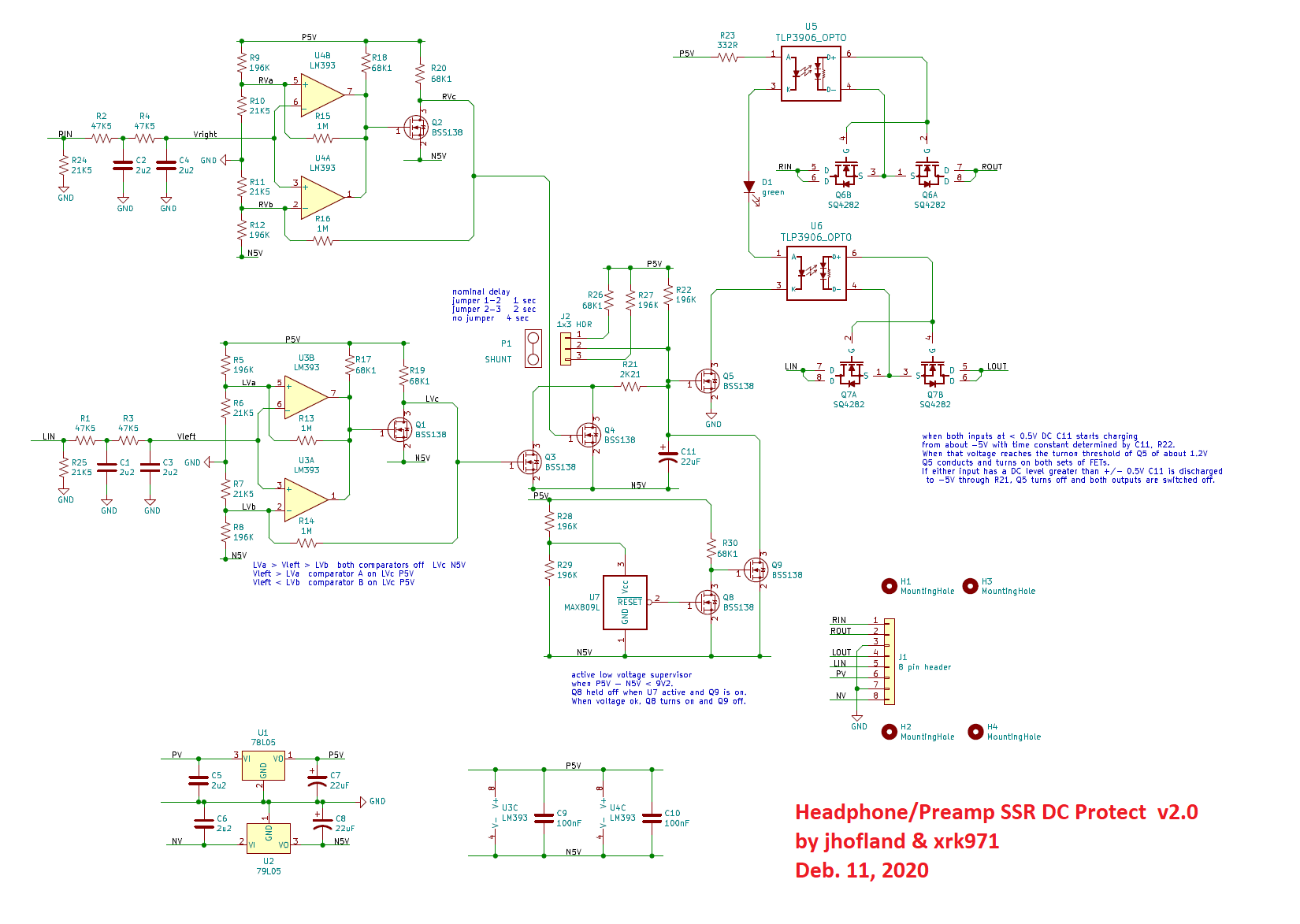
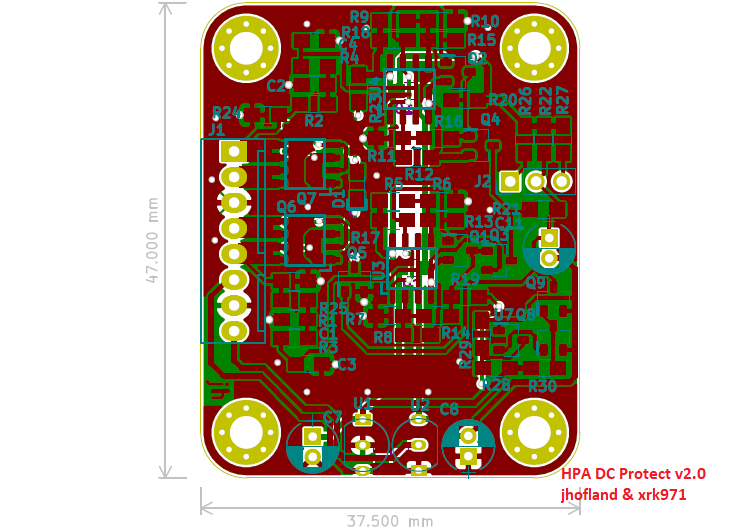

Attachments
Last edited:
Thanks Jhofland and X!! I’m in for a pair.
mbrennwa 2 RTR Switzerland
Gtkaudio 2 RTR USA
Vunce 2 DIY USA
mbrennwa 2 RTR Switzerland
Gtkaudio 2 RTR USA
Vunce 2 DIY USA
Would this also work for the output of a line preamp?
It appears the comparators are set to work at 0.5v which, assuming a dc amplifying power amp would be disastrous.
And while many seem to be happy passing audio signal through mosfet switches, there is just no need for such a compromise at the output of a pre - a simple shunting relay is just great in that position.
AnalogSA,
Perhaps you missed the whole discussion about how the SSR was measured and shown to have no impact on signal quality in the other thread? Tomchr pressed us on this and we measured it.
Ready-to-Run (RTR) SSR DC Speaker Protection and Delay GB
Same topology but on speaker level SSR:
Ready-to-Run (RTR) SSR DC Speaker Protection and Delay GB
Ready-to-Run (RTR) SSR DC Speaker Protection and Delay GB
Why would detection of DC at 0.5v be disastrous? There is a time constant so that a signal which persists at DC level longer than timescale of a 14Hz signal triggers the SSR relay to disconnect. The time constant is adjustable with the RC elements at the detection end.
Perhaps you missed the whole discussion about how the SSR was measured and shown to have no impact on signal quality in the other thread? Tomchr pressed us on this and we measured it.
Ready-to-Run (RTR) SSR DC Speaker Protection and Delay GB
Same topology but on speaker level SSR:
Ready-to-Run (RTR) SSR DC Speaker Protection and Delay GB
Ready-to-Run (RTR) SSR DC Speaker Protection and Delay GB
Why would detection of DC at 0.5v be disastrous? There is a time constant so that a signal which persists at DC level longer than timescale of a 14Hz signal triggers the SSR relay to disconnect. The time constant is adjustable with the RC elements at the detection end.
Last edited:
Perhaps you missed the whole discussion about how the SSR was measured and shown to have no impact on signal quality
Discussions are valuable and so are measurements, but in respect of mosfets being invisible in this application my ears stubbornly claim otherwise.
Why would detection of DC at 0.5v be disastrous?
This was only in the context of a line stage followed by a dc power amp. The speakers may see more than 10v dc before the 0.5v threshold is reached.
- Home
- Group Buys
- RTR SSR Headphone Amplifier DC Protection Modules GB

